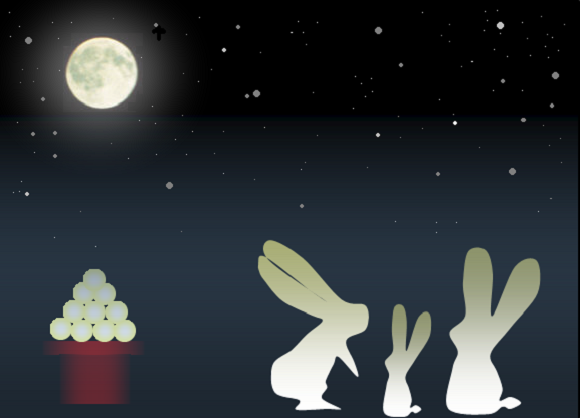
This week in Japan, people around the country are celebrating a special event known as tsukimi, literally “moon-viewing”. Celebrated on the 15th day of the lunar calendar (which lands sometime between September and October) it is the best time to look at the moon because the position of the earth, sun and moon make it appear especially big and bright. Just as with cherry blossom viewing, it’s a time to honor the beauty of nature with food, drink and friends.
One of the most traditional foods to celebrate with is called tsukimi dango which are sweets made of mochi (Japanese rice cake). But just as the Japanese dialect isn’t the same from Hokkaido to Okinawa, the look and taste of tsukimi dango vary from region to region. Here are three of the most interesting versions from across Japan!
This is a picture of what tsukimi dango looks like in many parts of Japan. They are simply mochi and often stacked on top of each other in a pyramid shape. Sometimes they are dipped in a delectable red bean sauce to add a touch of flavor.
▼By eating them you are celebrating good health, the bounty of the year’s harvest and the beauty of the moon!
How does this simple sweet transform in different places in Japan? Let’s start with Okinawa in the south.
In Okinawa, they don’t eat tsukimi dango but rather bufuchagi. It is essentially made of the same ingredients, but they sure do look strange. The red beans cover the outside of the mochi, and it’s actually very similar to another sweet called ohagi. People might be surprised by the size and the appearance of the whole red beans, but in Okinawa, it is said that red beans protect people from evil, so it is important to keep them intact.
▼No, demons…I will eat this and you will stay back!
Let’s move inland and head on over to Kansai!
▼Whoah, what is that!?! Is that a dango bug???
As you can see the shape and the presentation are totally different. The red bean paste forms a cute belt and the shape of the dango represents a taro root. Taro was an important crop during the harvest so they shaped the tsukimi dango like it.
▼ Taro is similar in taste to a sweet potato.
In the latter part of the Edo Period, people believed the white mochi represented the moon and the red bean paste represented the clouds covering the moon.
Our last stop on the tsukimi dango train is Nagoya, where we encounter some really colorful ones!
In Nagoya, the tsukimi dango comes in three different colors and are usually served together. If you think the white represents the moon, you would be mistaken!
Two of the colors are thanks to our friend taro again; the brown represents the taro with the skin on, and the white represents the taro with the skin off. The pink color’s only purpose seems to be to entertain children. Perhaps the bright pink color will make them think the dango is really sweet, but they’ll be in for a surprise when all they taste is mochi!
If any of these sweets have piqued your interest, you should give them a try! Just be warned that tsukimi dango is only around for a limited time each year. Which means you might have to wait a whole year to eat them! Good thing there are plenty of other sweets in Japan to try.
▼Like these bite-sized chocolate-covered ice cream.
Or if sweets aren’t your thing, there is always the limited-time tsukimi Burger from McDonald’s to entertain your palate.
▼The fall specialty burger in Japan.
Which ones have you tried? Are there other types of tsukimi dango you’ve seen in Japan? Let us know if the comments!
Sources: Matome Naver
Top Image: Flickr (Héctor García)